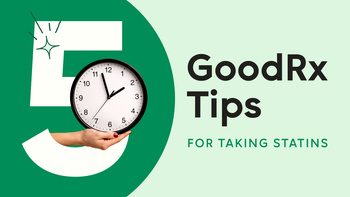
Muscle Pain From Statins? Here’s How to Avoid It
Key takeaways:
Statins are a popular group of prescription medications. They treat high cholesterol and help lower the risk of experiencing certain cardiovascular-related events, such as heart attacks and strokes. There are seven FDA-approved statins.
The most well-known statin side effect is muscle pain. This side effect can appear in a variety of ways and many people don’t experience it at all. Adjusting your dosage, taking a different statin, or trying another type of cholesterol-lowering medication altogether are all management options to consider.
Statins can cause other side effects as well, including headaches, stomach upset, and, potentially, an increased risk of diabetes. Your prescriber can help you manage these side effects in addition to muscle pain.
Access savings on related medications
Table of contents

Statins are one of the most popular classes of prescription medications. In fact, it’s estimated that almost a third of U.S. adults older than 40 take a statin. These potentially life-saving medications have several important medical uses. But they also have potential side effects.
One major downside is that they may cause muscle pain or muscle cramps — also known as statin-induced muscle pain. But muscle pain isn’t the only side effect linked to statin use.
Let’s find out why statins have been connected to muscle pain and what you can do to avoid it. We’ll also discuss other statin side effects to keep in mind.
Why do people take statins?
Statins prevent the liver from making too much cholesterol. But they’re also useful for other reasons. For example, people who are at high risk for heart disease can benefit from statins. This is because these medications help reduce the risk of hospitalization and death from severe cardiovascular-related events, such as heart attacks and strokes.
There are seven FDA-approved statins:
Atorvastatin (Lipitor, Atorvaliq)
Fluvastatin (Lescol XL)
Lovastatin (Altoprev)
Rosuvastatin (Crestor)
Simvastatin (Zocor, FloLipid)
Pitavastatin (Livalo, Zypitamag)
Read more like this
Explore these related articles, suggested for readers like you.
How often do people experience muscle pain with statins?
If you’re prescribed a statin, you should do your best to take it as directed. Though, some people find that challenging because of the medications’ side effects.
Muscle pain is the most common side effect reported with statins. According to some estimates, up to 20% of people taking statins experience this side effect. However, other data suggest this percentage is actually much lower.
Muscle pain from statins appears in a variety ways. For example, you could feel muscle weakness, soreness, aches, stiffness, or cramps. And these effects can range from mild to severe.
The older you are, the more likely you are to experience statin-induced muscle pain. Other factors that may increase your risk of this side effect include:
Being female
Being thin
Having a medical condition like diabetes, high blood pressure, untreated low thyroid, or kidney or liver disease
Not sure what’s causing your muscle pain? Learn about the many medications that can cause or contribute to this type of discomfort.
Does CoQ10 help with statin side effects? Here’s our breakdown of what experts know about CoQ10 and muscle pain related to statins.
A plethora of statins: Discover the similarities and differences between medications in the class in this statin comparison guide.
Why do statins cause muscle pain?
We don’t know for sure how or why statins cause muscle pain as a side effect. But researchers have a few ideas:
Genetics: Certain genes may make it more likely for people to experience muscle pain while taking a statin.
Low vitamin D: There is a possible link between low vitamin D and statin-related muscle pain. But more studies are needed to confirm this.
Calcium leakage: Calcium helps muscles contract. But when calcium leaks from muscle cells unintentionally, it can damage the cells and cause muscle pain and weakness. More recent studies suggest that statins may worsen unintentional calcium leakage, but more research is needed to confirm this.
Muscle fiber type: Muscles have two types of fibers: slow-twitch oxidative (type 1) fibers and fast-twitch glycolytic (type 2) fibers. The type 1 fibers help you with low-intensity and long-duration exercises. And the type 2 fibers help with high-intensity and short-duration exercises. If you have more type 2 muscle fibers, you’re more likely to have muscle pain from statins.
Low cholesterol in muscles: Statins may block muscle cells from making cholesterol. But it’s unknown if low cholesterol levels in muscles can cause muscle pain. More studies in this area are needed.
Mitochondrial dysfunction and free radicals: Mitochondria are energy-driving structures found in many human cells. Statins can prevent mitochondria from working properly. This may eventually lead to the presence of free radicals that play a role in statin-related muscle pain.
Is muscle pain a side effect of all statins?
Yes, all statins carry a risk of muscle pain. But minor differences in the individual medications impact how likely each one is to cause this side effect. Simvastatin is the most likely to cause muscle pain, while fluvastatin and rosuvastatin are the least likely. Other statins fall somewhere in between.
Of course, this isn’t the case for everyone. Figuring out which statin doesn’t cause muscle pain for you may require some trial and error.
Can muscle pain from statins be dangerous or life-threatening?
Dangerous muscle pain from statins is rare, but it’s possible. If you notice that your muscle pain is accompanied by dark-colored, brownish urine, it’s important to seek medical care right away. This could be a sign of a serious condition called rhabdomyolysis (muscle breakdown) that can lead to kidney failure and death if left untreated. Possible symptoms of rhabdomyolysis should be treated as swiftly as possible.
Does muscle pain from statins go away?
If you do experience muscle pain from a statin, you’ll likely notice it soon after you start taking the medication. For many people, this side effect is temporary and goes away relatively quickly. Though, someone who’s been taking a statin for a year or more without issue can suddenly develop muscle pain, cramps, weakness, or soreness. Granted, it’s difficult to tell if those muscle-related side effects are directly linked to the statin or if they’re caused by other health conditions.
If muscle pain is related to a statin, it should go away within 1 to 2 weeks of stopping the medication. If the pain doesn’t go away after stopping treatment, it may have been caused by something else.
Other than muscle pain, what side effects do statins cause?
In addition to muscle pain, these statin side effects have also been reported:
Headaches: This common side effect is estimated to affect up to 17% of statin users. If you experience headaches, they will likely get better as your body gets used to taking a statin. In the meantime, over-the-counter (OTC) treatment options, such as acetaminophen (Tylenol), may be helpful.
Stomach-related side effects: A number of people taking statins experience nausea, vomiting, or diarrhea at some point. There are many ways to manage these side effects, including temporarily adjusting your diet or taking an OTC nausea medication.
Diabetes: Some research indicates statins slightly increase the risk for diabetes. Some experts have found, however, that this risk is higher if you’re already at risk for developing diabetes or are taking a higher statin dosage. Research has also shown that statins may slightly worsen diabetes. Though, the benefits of statins outweigh these risks.
Kidney injury: Rhabdomyolysis related to statin use can cause kidney injury. But, in the absence of severe muscle breakdown, long-term use of statins isn’t connected to worsening kidney function. Though, a 2016 study suggested there’s a risk of kidney injury when taking a statin around heart surgery.
What are my options if a statin is causing unbearable muscle pain?
If you’re unable to tolerate your statin because of its effects on your muscles, here are four strategies you can consider.

1. Ask a pharmacist to review your entire medication regimen
Many medications and supplements can interact with statins, increasing the amount of statin in the body. If statin levels increase, you’re more likely to have muscle-related side effects. Examples of interacting medications include colchicine (Colcrys, Mitigare, Gloperba), Paxlovid (nirmatrelvir / ritonavir), and gemfibrozil (Lopid).
Asking your pharmacist to review your full medication list helps ensure there aren’t any drug interactions that could be causing or worsening your pain.
2. Ask your prescriber about trying a different statin
Let your prescriber know as soon as possible if you begin to have muscle pain while taking your statin. They will likely do a physical exam and run tests to see whether the statin is actually the cause. If so, they may ask you to switch to another one to see if your muscle pain improves.
In fact, experts recommend this approach, which has helped many people tolerate at least one statin. So it’s probably worth trying another statin or two before writing all of them off.
You can also ask your prescriber about CoQ10, a supplement that could potentially help with muscle-related side effects from statins.
3. See if your prescriber can adjust your dosage
Another option is asking your prescriber about adjusting your statin dosage. In some cases, higher statin dosages can lead to worse muscle pain. So a lower dosage may be just your answer.
Along similar lines, taking your statin less frequently may also do the trick. Some people find side effect relief by taking their statin every other day rather than every day. Another option is taking a temporary break from the medication and seeing how your body responds.
However, don't make any adjustments on your own. Your prescriber can help you decide if any dosage adjustments are appropriate based on your situation.
4. Consider an alternative cholesterol-lowering medication
While statins are among the most effective medications for getting cholesterol to target, they certainly aren’t the only options. Ask your prescriber whether it may be appropriate for you to try another cholesterol-lowering medication, such as ezetimibe (Zetia), bempedoic acid (Nexletol), or fenofibrate (Tricor). But don’t stop taking your statin without talking to your prescriber first.
The bottom line
Statins are effective at lowering cholesterol and reducing the risk of cardiovascular problems. Many people, however, have concerns about statins and side effects like muscle pain. Fortunately, there are several ways you can manage muscle pain and other statin side effects.
If you’re experiencing muscle pain, your prescriber may recommend lowering your statin dosage, taking a break from the medication, or switching to a different statin. It’s important to remember that the benefits of taking a statin outweigh the risks for most people.
Why trust our experts?



References
Abed, W., et al. (2022). Statin induced myopathy among patients attending the National Center for Diabetes, Endocrinology & Genetics. Annals of Medicine Surgery.
Bitzur, R., et al. (2013). Intolerance to statins: Mechanisms and management. Diabetes Care.
British Heart Foundation. (2019). Scientists identify potential cause of statin-related muscle pain. ScienceDaily.
Grundy, S. M., et al. (2018). AHA/ACC/AACVPR/AAPA/ABC/ACPM/ADA/AGS/APHA/ASPC/NLA/PCNA guideline on the management of blood cholesterol: A report of the American College of Cardiology/American Heart Association task force on clinical practice guidelines. Circulation.
Kwak, H. B. (2014). Statin-induced myopathy in skeletal muscle: The role of exercise. Journal of Lifestyle Medicine.
Mansi, I. A., et al. (2021). Association of statin therapy initiation with diabetes progression: A retrospective matched-cohort study. JAMA Internal Medicine.
Mlodinow, S. G., et al. (2014). Statin adverse effects: Sorting out the evidence. The Journal of Family Practice.
National Human Genome Research Institute. (2024). Mitochondria.
Newman, C. B., et al. (2018). Statin safety and associated adverse events: A scientific statement from the American Heart Association. Arteriosclerosis, Thrombosis, and Vascular Biology.
Pergolizzi, J. V., et al. (2020). Statins and muscle pain. Expert Review of Clinical Pharmacology.
Picard, M., et al. (2012). Mitochondrial function specialization in glycolytic and oxidative muscle fibers: Tailoring the organelle for optimal function. American Journal of Physiology-Cell Physiology.
Qu, H., et al. (2018). Effects of coenzyme Q10 on statin-induced myopathy: An updated meta-analysis of randomized controlled trials. Journal of the American Heart Association.
Reith, C., et al. (2022). Effect of statin therapy on muscle symptoms: An individual participant data meta-analysis of large-scale, randomised, double-blind trials. The Lancet.
Robinson, J. G. (2015). Statins and diabetes risk: How real is it and what are the mechanisms? Current Opinion in Lipidology.
Salami, J. A., et al. (2017). National trends in statin use and expenditures in the US adult population from 2002 to 2013: Insights from the Medical Expenditure Panel Survey. JAMA Cardiology.
Sattar, N., et al. (2010). Statins and risk of incident diabetes: A collaborative meta-analysis of randomised statin trials. Database of Abstracts of Reviews or Effects (DARE).
Shannon, J., et al. (2012). Statin-associated myopathy. U.S. Pharmacist.
Sizar, O., et al. (2024). Statin medications. StatPearls.
Zheng, Z., et al. (2016). Perioperative rosuvastatin in cardiac surgery. The New England Journal of Medicine.





























